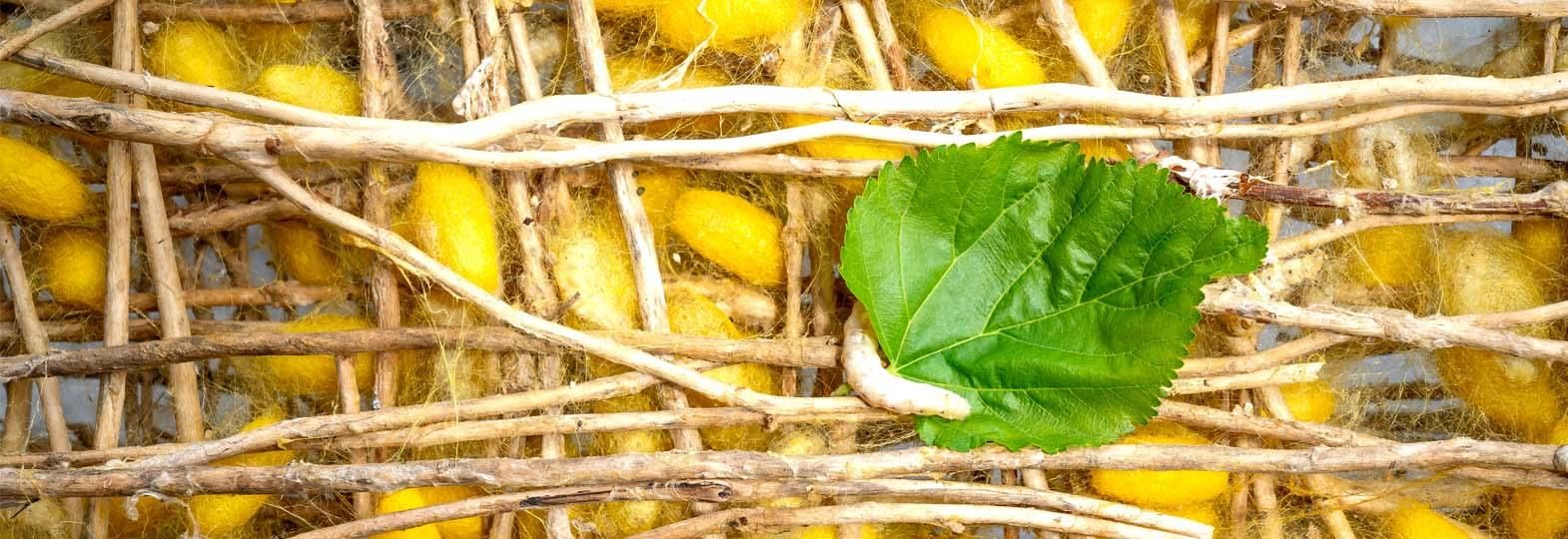Silks of India are classified based on the varieties of silkworms from which they are spun. The differences of silk are due to both the organisms (the species and eco-races of the insect) and the species of the host food plant. It is indeed very interesting to learn that there is very specific insect-host food plant relationship, i.e., the insect species is not capable of surviving on any host food plant; rather it is very selective, since it can use leaf of only some of the plant species as its food.
The most commonly known silk is produced by the cocoon of the silk insect Bombax mori. Its food plant is the Mulberry tree species Morus ulba, which also multiplies easily by vegetative propagation. The leaves of this plant are fed to the larvae of the silk insect, even in homes; as such this is the only type of silk grown by domestic cultivation. It is worth mentioning here that the size of the full-grown silkworm and the cocoon formed by it varies from species to species of the silkworm. The silkworm as well as the cocoon size of domestic cultivation species Bombax mori is much smaller compared to the Tasar silkworm species Antheraea mylitta, the host food plant of which are forest trees of Arjun, Asan and Sakhua. What makes a Tasar silk unique is that it is indigenous and comes from the moth Antheraea mylitta which feeds on the trees in the wild forests, and that’s the reason why they are referred to as ‘wild silk’.
Production of cocoon by the Tasar silkworm insect (Antheraea mylitta) on the food plants of Arjuna (Terminalia arjuna), Asan (Terminalia tomentosa) and Sal or Sakhua (Shorea robusta) in the forests of Jharkhand state, mainly in the Kolhan and South Chotanagpur divisions, is a source of additional income and livelihood for the tribals and other local people.
However, due to the ever-increasing human population and developmental activities, the areas of forests are depleting. The indiscriminate felling of trees, including Tasar food plants, is resulting in gradual diminishing of silkworm population. This is adversely affecting not only the livelihood prospects of the collectors and producers of cocoon but is also leading to the loss of eco-races of both the food plants and the insects. In turn, it is adversely affecting the livelihood of other people associated with this industry, i.e., spinners of the yarn, weavers of textile and the artisans, the apparel designers and producers.
There is an increasing international demand of Kuchai Tasar, an organic Tasar produced mainly in the Seraikela-Kharsanwa area of south Jharkhand state. To achieve increasing targets of its yarn, textile, apparel etc, there is an urgent need to involve and educate the local population as well as the government personnel to conserve both the food plants and the Tasar silkworm.
Conservation is not just about avoiding extinctions but is also about restoring or recovering species populations to secure the previous levels and preventing other species from reaching such a shaky situation in the first place.
Although each species shares the same domain, they have their own particular ecological requirement too that makes them unique and special. Habitat loss has historically been a factor in species decline. However, the way existing habitats are managed is also important. Restoring habitat and managing it correctly is not always enough to return species to areas from which they have been lost. India is a mega-biodiversity country, with great wealth of microbial, plant and animal species and as many as 4,00,000 of these are probably yet to be documented.
To obtain more organic Tasar cocoon, steps to increase the population of their habitat trees, both in the natural forests as well as in and around the villages, need to be taken. Conservation of species cannot be done in isolation without protection of its habitat. Biodiversity conservation needs emphasis on generating employment of local people depending on forest resources. To ensure their active participation and support in biodiversity conservation, the local population must be assured that their livelihood and sustenance are secure.
Therefore, bio-conservation of the food plants as well as the non-food plants (for the survival of forest wildlife) and the Tasar silkworm is the need for sustainable livelihood of the cocoon growers and collectors and also the producers of garments from this wonderful silk yarn. In fact, there is an urgent need of framing a bio-conservation management plan for the prosperity of this important industry.








Comments